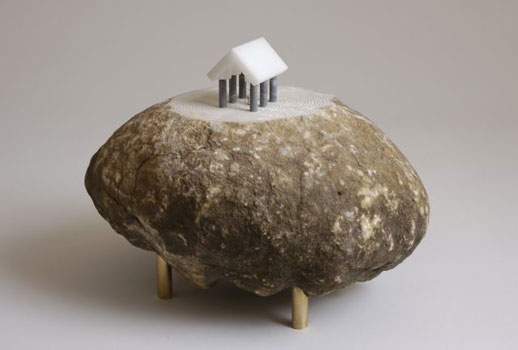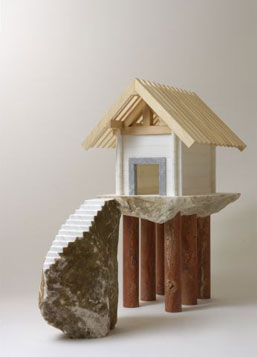In search of a sanctuary
Amongst the season of intense heat waves, hanabi festivals and beach parties, it is almost natural for us local Tokyoites to look for a place to cool down from the energetic summer hype. Composed of minimal representation of balance, meditation and stillness, Isao Sugiyama “Santuario” exhibition at Tokyo Gallery can be that sanctuary. An experience that not only calms the body and the mind, the exhibition also portrays a less-seen style of art in the current trend: art devoid of shock value, emphasizing the calmness of senses rather than provocation.
Sugiyama’s influences are both from his European style sculptural background and his Japanese root that drives his aesthetic sense of simplicity and stillness. Graduated in 1977 from the sculpture department at Zokei University, he continued his education at the Academy of Fine Arts in Carrera, Italy. While living and working in Milan and Carrera, Sugiyama exhibited both in solo and group exhibitions mainly in European countries. “Santuario” marks Sugiyama’s solo exhibition in Tokyo first time in twenty years.

Sugiyama’s sculptures somewhat closely resemble Greece’s famous Meteora monasteries in miniature, with a sprinkle of Asian twists. Standing on representational cliffs, the house-like structures, while seems neutral in marble, can also be closely identified with modern Japanese architectural aesthetics when done in wood, especially in their style of organized simplicity. The carved lines on the base marble in many of the sculptures also most likely aim to recreate Sugiyama’s own version of Japanese stone gardens. Besides being aesthetically representational in its revolving circular style, these also reinforce similar ideas of meditation and stillness.
 The relationship of balance and meditation is also explored through the balancing sculptures of ‘Santuario 304°’, ‘Santuario 159°’ and ‘Santuario 135°’. With their structures tricking the eyes into believing that the balance will fail if tampered, viewers are faced with a literal butterfly-in-your-stomach sensation, like when we face the fear of falling and losing balance ourselves. The idea of meditation is related here through the viewers’ interaction with the piece, where we subconsciously concentrate on our own movements and our distance from the sculptures for fear of causing the balance to fail. Our concentrated steps became somewhat like a walk of meditation, where we unknowingly focus on our every move. Through these mental interactions with the sculptures, we the viewers are able to experience a sense of stillness and the extent of meditation ourselves just by walking through the exhibition.
The relationship of balance and meditation is also explored through the balancing sculptures of ‘Santuario 304°’, ‘Santuario 159°’ and ‘Santuario 135°’. With their structures tricking the eyes into believing that the balance will fail if tampered, viewers are faced with a literal butterfly-in-your-stomach sensation, like when we face the fear of falling and losing balance ourselves. The idea of meditation is related here through the viewers’ interaction with the piece, where we subconsciously concentrate on our own movements and our distance from the sculptures for fear of causing the balance to fail. Our concentrated steps became somewhat like a walk of meditation, where we unknowingly focus on our every move. Through these mental interactions with the sculptures, we the viewers are able to experience a sense of stillness and the extent of meditation ourselves just by walking through the exhibition.
Each of Sugiyama’s sculptures, while all seem to have individual narrative backgrounds concerning different ideas (such as different aesthetics, balance and meditation), also patently holds a set of themes that makes them a single exhibition. Sugiyama explores the idea, very much like the raison d’être of Meteora Monasteries, of religion and isolation from civilization. References to religion are visible and portrayed almost literally through the structures. They seemingly represent isolated monasteries on cliffs, a Zen atmosphere derived from the aesthetic style of Japanese stone gardens, and a subtext of sanctuaries in discernible in the collection as a whole.
 However, these references can also be more closely associated with another meaning of “religion,” as a place that provides mental peace, rather than religion as a movement of collective belief. The contrast of raw, unprocessed marbles with wood and processed marble structures also shows man’s incapability of full isolation from civilization. One is unable to be fully cut out from the learnings and the world created by man, for it is still an essential part of staying alive. The theme is straightforwardly portrayed by the house-like sculptures that, though isolated, still represent influences by civilization, contrasted against the marble that represents nature, devoid of any civilized touch.
However, these references can also be more closely associated with another meaning of “religion,” as a place that provides mental peace, rather than religion as a movement of collective belief. The contrast of raw, unprocessed marbles with wood and processed marble structures also shows man’s incapability of full isolation from civilization. One is unable to be fully cut out from the learnings and the world created by man, for it is still an essential part of staying alive. The theme is straightforwardly portrayed by the house-like sculptures that, though isolated, still represent influences by civilization, contrasted against the marble that represents nature, devoid of any civilized touch.
The exhibition is filled with a sense of peace and stillness; a result of a clear combination of soft lighting that showers the whole room, a sense of vast space due to the minute size of the little sculptural houses, the sculptural relationships between the aesthetic of marbles and wood, and the religious references that calm the mind. With an absolute sense of peace intensely muting all other activities once inside the small gallery space, Sugiyama’s “Santuario” exhibition can be truly both a sanctuary and a very calming, yet thought-provoking experience on a hot summer day.
Cheri Pitchapa Supavatanakul
Cheri Pitchapa Supavatanakul



